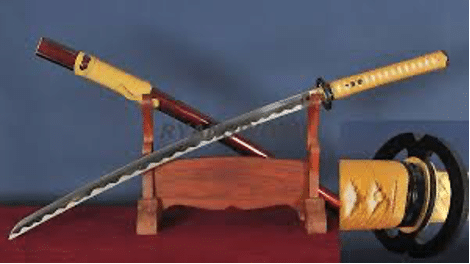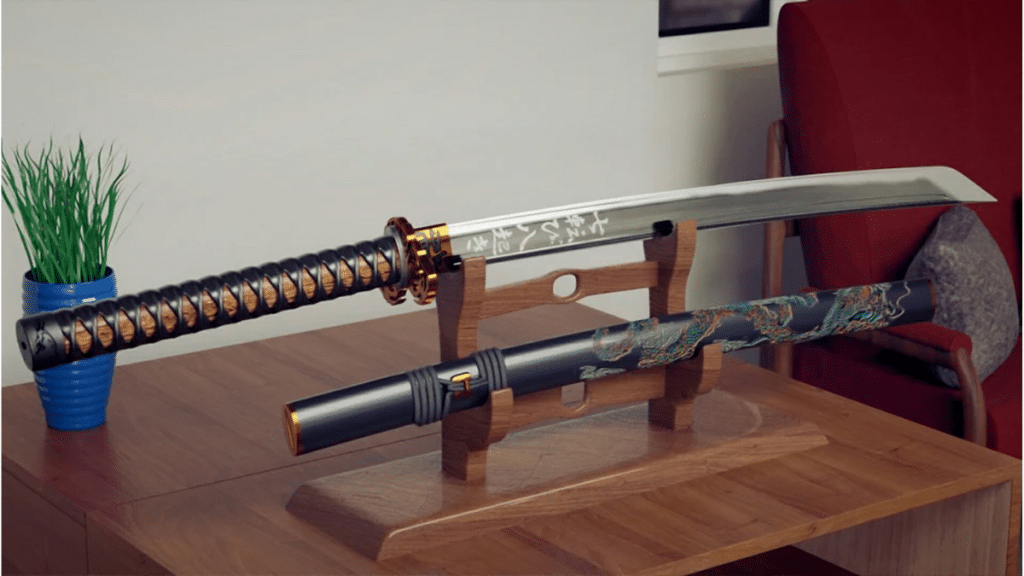Owning a Japanese Katana sword is like holding a piece of history. The beauty and skill involved in making these swords attract many collectors and fans. In this guide, we’ll look at what makes Katanas special, how to choose your first one, and what to check for quality and authenticity. Whether you’re new or experienced, knowing these details will help you choose wisely. Join us and explore the amazing world of Japanese Katana swords.
The Rich History and Cultural Significance of the Katana
The Katana, often referred to as the Samurai sword, has a deep and storied past. This iconic weapon is not just a tool but a symbol of Japanese heritage and craftsmanship.
The Origins of the Katana
The history of the Katana dates back to the Kamakura period (1185-1333). During this time, swordsmiths began to create curved blades. These were more effective in combat than the straight swords previously used. The Katana’s design allowed for quick, precise strikes, making it a favorite among Samurai warriors.
Evolution Through the Ages
As Japan transitioned through different eras, the Katana evolved. In the Muromachi period (1336-1573), the design was refined for both beauty and function. Swordsmiths like Masamune became legends, creating blades that were not only deadly but also works of art. The Edo period (1603-1868) saw the Katana become a status symbol. Samurai wore them as a sign of their rank and honor.
The Samurai and Their Swords
The Samurai were more than just warriors, they were the keepers of peace and justice. Katana was the companion of Samurais which symbolizes their soul. It was believed that a Samurai’s spirit resided in their sword. This belief elevated the Katana from a mere weapon to a sacred object.
Cultural Impact and Legacy
The Katana has left an indelible mark on Japanese culture. It appears in countless stories, films, and artworks. The reverence for this sword continues today. Modern practitioners of martial arts like Kendo and Iaido use the Katana in their training. Collectors worldwide seek these blades for their historical and aesthetic value.
The Katana is more than just a Samurai sword; it’s a symbol of a rich cultural heritage. Understanding its history and significance gives us a deeper appreciation for these remarkable blades. Whether you’re a collector or a martial artist, the allure of the Katana is undeniable.

Exploring the Various Types of Katanas
The world of Katanas is vast and fascinating. Each type of Katana offers unique features and purposes, reflecting the rich history of Japanese swordsmanship.
Shinogi-Zukuri
Shinogi-Zukuri is the most common Katana sword type. It features a distinct ridge line called the “shinogi.” This design enhances the blade’s strength and cutting ability. The curved shape makes it ideal for swift, precise strikes. It’s widely used in traditional martial arts.
Kissaki-Moroha-Zukuri
Kissaki-Moroha-Zukuri stands out with its double-edged blade. Unlike typical Katanas, both edges are sharpened. This makes it versatile for thrusting and slicing. The pointed tip, or “kissaki,” allows for deadly accuracy. It’s a rarer design but highly valued by collectors.
Hira-Zukuri
Hira-Zukuri has a flat, thin blade without a shinogi ridge. This gives it a sleek, minimalist appearance. It’s exceptionally sharp, perfect for cutting soft targets. However, it’s less durable in heavy combat. This type is often seen in smaller blades like the tanto.
Unokubi-Zukuri
Unokubi-Zukuri, or “cormorant neck,” features a distinctive shape with a thinner section near the blade’s spine. This reduces weight while maintaining strength. The design allows for faster handling and quicker strikes. It’s favored in martial arts requiring agility and speed.
Shobu-Zukuri
Shobu-Zukuri resembles Shinogi-Zukuri but without a defined yokote, the line separating the blade from the tip. This creates a continuous curve from the blade to the tip, enhancing its aesthetic appeal. It’s known for its robust structure and powerful cutting capability.
Kanmuri-Otoshi-Zukuri
Kanmuri-Otoshi-Zukuri has a thicker base and a thinner tip. This design offers balance and control, making it easier to handle. The blade’s weight distribution provides excellent slicing power with less effort. It’s a practical choice for both display and use.
Each type of Katana brings something unique to the table. Understanding these differences helps in choosing the right sword for your needs. Whether for martial arts, collection, or display, the variety of Katana sword types ensures there’s a perfect match for everyone.
Key Parts of a Katana Explained
Understanding the terminology of a Katana or Samurai Sword is essential for any enthusiast. Knowing these terms will deepen your appreciation and knowledge of these exquisite swords.
Tsuka (Handle)
The Tsuka is the handle of the Katana. It’s typically made from wood and wrapped in ray skin (samegawa) and cord (ito). This wrapping provides a firm grip. The Tsuka is often adorned with Menuki, small decorative ornaments, which enhance both grip and aesthetics.
Saya (Scabbard)
The Saya is the scabbard that houses the blade. Made from wood, it is often lacquered and can be highly decorative. The Saya protects the blade from damage and corrosion. It also adds to the overall presentation of the sword.
Hamon (Blade Pattern)
The Hamon is the visible pattern on the blade, created during the tempering process. This pattern is unique to each sword and serves both functional and aesthetic purposes. It indicates the hardened edge and adds to the blade’s beauty.
Tsuba (Guard)
The Tsuba is the guard located between the blade and the handle. It protects the hand from sliding onto the blade during use. Tsubas can be simple or highly ornate, often reflecting the swordsmith’s artistry.
Nakago (Tang)
The Nakago is the tang, the part of the blade that extends into the handle. It’s crucial for the sword’s balance and strength. The Nakago is usually signed by the swordsmith, adding to the sword’s historical value.
Kissaki (Tip)
The Kissaki is the tip of the blade. It’s carefully shaped and polished to a sharp point. The Kissaki’s design is critical for thrusting and precise cuts. Its shape varies among different types of Katanas.
Mekugi (Peg)
The Mekugi are small bamboo or metal pegs that secure the Tsuka to the Nakago. These pegs are vital for the sword’s stability. They allow for easy disassembly and maintenance.
Habaki (Blade Collar)
The Habaki is a metal collar around the base of the blade. It ensures a tight fit between the blade and the Saya. The Habaki also aids in drawing and sheathing the sword smoothly.
Fuchi and Kashira (Handle Fittings)
The Fuchi is the collar at the top of the Tsuka, while the Kashira is the pommel at the bottom. These fittings reinforce the handle and often match the Tsuba’s design. They add both strength and beauty to the Katana.

Knowing these parts and their functions enhances your understanding of Katanas. Each element plays a vital role in the sword’s performance and aesthetic. Whether you’re a collector or a martial artist, mastering this terminology is key to appreciating these remarkable swords.
Choosing the Right Katana for Beginners
Choosing your first Katana can be exciting but confusing. With many options available, it’s important to find the right one for you.
What to Look for in a Beginner Katana
When picking a beginner Katana, focus on strength and ease of use. Look for a blade made from high-carbon steel. This type of steel is strong and sharp. Make sure the handle (Tsuka) is well-made and provides a firm grip. A full tang blade, where the metal goes through the handle, offers better control and balance.
Balance Between Quality and Price
Finding the right balance between quality and price is key. While high-end Katanas can be expensive, there are affordable options that are still well-made. Avoid very cheap swords, as they might be unsafe. Aim for a mid-range Katana that offers good craftsmanship and materials without being too costly.
Recommended Types and Brands
For beginners, the Shinogi-Zukuri style is often suggested. This type has a ridged blade that is strong and versatile, making it perfect for new users. Brands like Hanwei and Musashi are known for their reliable and well-crafted Katanas for beginners. Hanwei’s Practical Katana series is popular for its quality and affordability. Musashi offers a range of options that combine traditional looks with modern performance.
At our store, Japan Oni Mask, we offer a selection of high-quality beginner Katanas. Our swords are carefully crafted to ensure you get the best start in your Katana journey. Visit us to explore our collection and find the perfect Katana for you.
Katana Safety and Legal Considerations
Owning a Katana comes with important responsibilities. Knowing how to handle and store your Katana safely, and understanding the laws in your area, is essential.
Safety Tips for Handling and Storage
When handling a Katana, always use both hands. This gives you better control and prevents accidents. Keep your fingers away from the sharp edge. When drawing the sword from its scabbard, do it slowly to avoid slipping and cutting yourself.
For storage, use a strong stand or display case. This keeps the blade safe and out of reach. Make sure the Katana is clean and dry before storing it. This prevents rust. Check your sword regularly for any signs of damage.
Legal Restrictions in Different Regions
Katana laws are different everywhere. You can own a Katana but can’t carry it in public at some pleaces. In the United States, you can own a Katana, but carrying it in public is often restricted. Always check your local laws before buying or moving your Katana.
Owning a Katana is legal, but some types, like those with curved blades over 50 cm, have restrictions in the UK. In Japan, you need to register your Katana and get a license. The rules are strict because Katanas are part of their cultural heritage.
In conclusion, buying a Katana for beginners involves understanding key aspects like types, safety, and legal considerations. With the right knowledge, you can start your journey with confidence. Ready to find your perfect Katana? Explore our Katana collection today and take the first step into this fascinating world.
